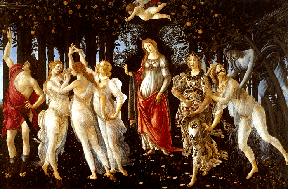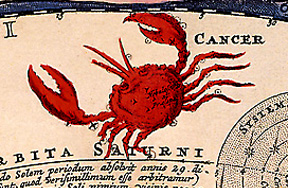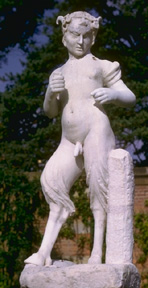Statue of Pan. Hever Castle, Kent, England.
Click on image for full size
Image courtesy of Corel Corporation.
Faunus
Faunus was a Roman pastoral god. The Romans identified him with the Greek god
Pan. Some times the Greek god Pan was associated with the different Roman deity Silvanus, the god of wild nature. Like his Greek counterpart, he had the legs and horns of a goat.
Faunus was an oracular deity. He was able to predict the future that was revealed to him in dreams or in supernatural voices coming from sacred groves. He was also considered a very good musician.
Pan was singing one day and boasted he was a better musician than Apollo. A contest was held between the two, with Tmolus serving as judge. Apollo had a much better instrument than Pan, and was chosen the winner. Even though Tmolus chose Apollo as the winner, King Midas disagreed. Tmolus turned the king's ears into donkey ears as punishment.
You might also be interested in:

In Greek mythology, Apollo was the son of Zeus (Jupiter) and Leto (Letona). He was the twin brother of the goddess Artemis. He was the god of the Sun, logic, and reason, and was also a fine musician and
...more
Ahsonnutli was the sky father and chief god for the Navajo. He created heaven, Earth, and the sky. Each of the four directions, or cardinal points, are supported by a giant. Each direction is symbolized
...more
Amphitrite was one of the sea-nymphs called the Nereids. One day the sea god Poseidon saw her dancing and fell desperately in love with her. He promptly asked her to marry him but unfortunately she refused.
...more
Aphrodite was the Greek goddess of love and beauty. She was known to the Romans as Venus. To the perfection of her figure and the purity of her features she added an innocent grace. On her sweet face she
...more
In Greek mythology, Apollo was the son of Jupiter(in Greek Zeus) and Leto (Letona). He was the god of the Sun, logic, and reason, and was also a fine musician and healer. Leto travelled all over Greece
...more
According to an ancient Greek legend, the figure of a gigantic crab was placed in the nighttime sky by the goddess Hera to form the constellation Cancer. Hera swore to kill Heracles, the most famous Greek
...more
In the Northern Hemisphere sky is the constellation Cepheus, king of Ethiopia, and that of his wife Cassiopeia. Cassiopeia claimed that she and her daughter Andromeda were more beautiful than the sea nymphs,
...more















